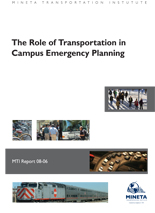- 408-924-7560
- mineta-institute@sjsu.edu
- Donate
The Role of Transportation in Campus Emergency Planning
In 2005, Hurricane Katrina created the greatest natural disaster in American history. The states of Louisiana, Mississippi and Alabama sustained significant damage, including 31 colleges and universities. Other institutions of higher education, most notably Louisiana State University (LSU), became resources to the disaster area. This is just one of the many examples of disaster impacts on institutions of higher education. The Federal Department of Homeland Security, under Homeland Security Presidential Directive–5, requires all public agencies that want to receive federal preparedness assistance to comply with the National Incident Management System (NIMS), which includes the creation of an Emergency Operations Plan (EOP). Universities, which may be victims or resources during disasters, must write NIMS–compliant emergency plans. While most university emergency plans address public safety and logistics management, few adequately address the transportation aspects of disaster response and recovery. This MTI report describes the value of integrating transportation infrastructure into the campus emergency plan, including planning for helicopter operations. It offers a list of materials that can be used to educate and inform campus leadership on campus emergency impacts, including books about the Katrina response by LSU and Tulane Hospital, contained in the report´s bibliography. It provides a complete set of Emergency Operations Plan checklists and organization charts updated to acknowledge lessons learned from Katrina, 9/11 and other wide–scale emergencies. Campus emergency planners can quickly update their existing emergency management documents by integrating selected annexes and elements, or create new NIMS–compliant plans by adapting the complete set of annexes to their university´s structures.
ADDITIONAL RESOURCES
Frances L. Edwards, MUP, PhD, CEM
Frances L. Edwards is the Director of the Master of Public Administration program and Professor of Political Science at San Jose State University (SJSU). She is also a Research Associate at MTI, and teaches emergency management in the Master of Transportation Management program.
Previously, she was Director of the Office of Emergency Services in San Jose, California for 14 years, including one year as acting assistant chief, San Jose Fire Department. She was Director of San Jose´s Metropolitan Medical Task Force (MMTF), a CBRNE terrorism response unit, and head of the four–county "San Jose Urban Area Security Initiative".
Dr. Edwards has a PhD in public administration, a Master of Urban Planning, MA in Political Science (International Relations) and a Certificate in Hazardous Materials Management.
DANIEL C. GOODRICH, MPA, CEM
Daniel C. Goodrich is an emergency preparedness coordinator for Lockheed Martin Space Systems Company. He is an instructor and Research Associate at MTI, where he also teaches Security for Transportation Managers. He has been an active member of the San Jos?Metropolitan Medical Task Force, a CBRNE response unit, since 1999, where he has served as exercise director for eight facilitated exercises, a model of ex–ercise that he developed.
Mr. Goodrich serves as a consultant to the California Department of Transportation (Caltrans), and has provided training services for NASA/Ames Research Center staff in emergency management. He has a Master of Public Administration degree from SJSU, and is a Certified Emergency Manager.
-
Contact Us
San José State University One Washington Square, San Jose, CA 95192 Phone: 408-924-7560 Email: mineta-institute@sjsu.edu






